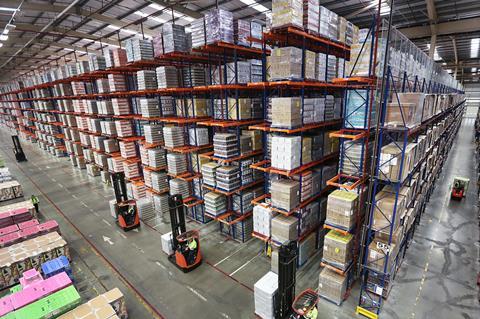
Millions of pallets of unusable personal protective equipment (PPE) are clogging up warehouses and affecting supermarket supply chains.
Supply chain and distribution experts have told The Grocer that warehouses being full of immovable PPE was adding to concerns about ongoing labour shortages and resulting in reduced availability in supermarkets, particularly on fast-moving lines like chilled.
“Effects on the retailers is more out-of-stocks, especially on chilled lines where there is no buffer stock position at retail RDCs and an erosion of the available shelf life available to retailers,” said supply chain specialist Oakland International CEO Dean Attwell.
The UK Warehousing Association (UKWA) CEO Clare Bottle told The Grocer a “high proportion” of PPE ordered during the pandemic – including ventilators, scrubs and lateral flow tests – was taking up space in warehouses across the country.
According to the Department of Health and Social Care, as of 26 September 2022, there were 7.4 billion items of PPE stored in UK warehouses.
Logistics operators have warned that this was affecting overall warehouse capacity space – therefore contributing to poorer availability in stores. More delayed inbound stock that arrived from Asia during and after the pandemic, as well as brands and retailers “stockpiling” over fears of further supply chain uncertainty amid lower consumer demand, was also having an effect.
“Warehouses are pretty full to capacity everywhere at the moment, and a lot of that is driven by the reduced confidence in the inbound supply chain,” Attwell said.
“Clearly there have been challenges with China and fears of further supply chain shutdowns. Then we have the issues of potential strikes again at Felixstowe and possible delays at ports due to continued Brexit border challenges.
“We believe that more suppliers are now taking the view that it is better to hold more stock closer to their final delivery destinations rather than run quite so hand-to-mouth.”
Recent data from supply chain software developer Unleashed revealed businesses in the beverage industry were holding 115% more stock compared with pre-pandemic levels.
Wincanton MD James Hurrell confirmed that grocers and brands were “finding it challenging to predict customer demand” against the current economic background, so had resorted to stockpiling over fears of future disruption.
However, trading patterns had been affected by the cost of living crisis and patchy consumer demand, making forecasting harder, added Colliers logistics expert Andrea Ferranti.
“Supermarkets might not say that but what happens when there is an economic downturn is that forecasting becomes even more difficult so you might end up with certain items which don’t sell.”
Simply Supply Chain director Jonathan Kittow confirmed that warehouses were notably “far fuller of stock than they would expect” ahead of the peak trading period as “people built for Christmas on the basis of higher demand”.
“The good news is that if sales at Christmas peak, then the stock is there,” he said. “But whether you can get it out to them is another matter because of labour [shortages] in the warehouse,” which Kittow said was a “primary constraint”.
He claimed this would “inevitably impact RDC-to-store availability”, which was “well below where it used to be”.
Oakland’s Attwell confirmed the business was seeing “a lot of operators in our sector creaking through strains of overstocked warehouses and labour shortages at driver and warehouse level”.



















No comments yet